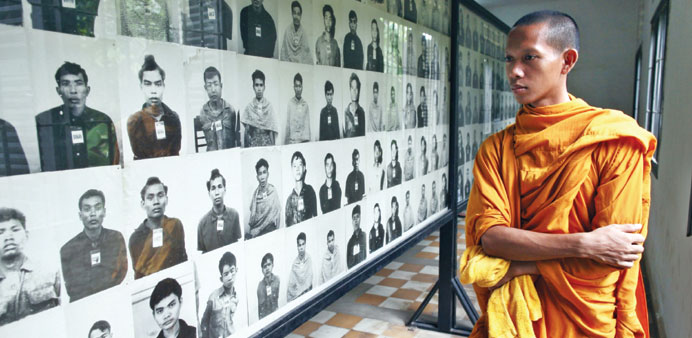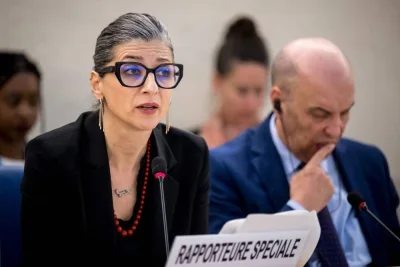A Cambodian monk looks at photos of victims at the Tuol Sleng Genocide museum in Phnom Penh province.
By Harriet Fitch Little/The Guardian/Phnom Penh
The faces follow you through the rooms. Some are terrified, some eager to please, others too distorted by beatings to look at the camera straight on.
It is these photos, tacked to boards in a former high school in Phnom Penh, that give human meaning to the abstract horror of nearby torture instruments and cases full of bones.
Each headshot shows a prisoner on arrival at what was the notorious S-21 interrogation centre in the heart of the Cambodian capital, moments after their blindfold was removed.
Four decades later, visitors to the centre - now the Tuol Sleng Genocide museum - know with near-certainty that they are looking into the eyes of the dead. It is widely believed that, of more than 12,000 people imprisoned here, 14 survived.
Friday marked 40 years since the Khmer Rouge first marched into Phnom Penh. Over the following 44 months in the region of 2mn people from a population of just over 8mn died -- killed, starved or struck down by disease -- as Pol Pot’s brutal regime attempted to style Cambodia into a classless, agrarian society.
Cambodia is still struggling to deal with its history, where personal memory is politicised and the spectre of the Khmer Rouge is ever-present but often wilfully ignored.
Even the most basic term remains contentious: can a regime be described as genocidal when so much of the killing of Khmers was done by Khmers?
Nhem En, a survivor of sorts from that dark time, is an unwelcome reminder of a knot of dilemmas that Cambodia is only starting to untangle – who to blame; how to forgive; and how to understand a regime that implicated such large swaths of the population in seemingly unfathomable cruelty.
As Tuol Sleng’s photographer, Nhem Ene knows the faces that line the museum’s walls.
On a raised terrace opposite the museum entrance, he has set up shop. Barrel-chested, leather-skinned and eager for custom, he sought out tourists as they emerged into the scrum of tuk-tuks and tour buses, and tried to sell them his autobiography.
Nhem En is not officially welcome here. His writings are not on sale in the gift shop, and the government recently refused him a licence for a stall inside the museum.
Officialdom has decided he is not a victim, and it does not encourage him to contest that status.
“He might give the wrong answers,” says a government representative when asked why it does not sanction the photographer speaking publicly about his experiences.
Nhem En is disinclined to be silent, partly because he does not see himself as guilty. He joined the revolution as a child, he says, and was still a teenager when he was sent to study photography in China.
“If I had not followed Angkar’s (the name given to the Khmer Rouge leadership) orders I would have been killed,” says the 55-year-old.
To museum visitors who carry with them the recent memory of each prisoner’s piercing gaze, Nhem En’s impassive declaration of innocence may be hard to stomach.
And the photographer is far from a sympathetic advocate: before starting his career as a self-published author, he tried to sell Pol Pot’s sandals and toilet seat online.
But questions of guilt and innocence at Tuol Sleng run far deeper than Nhem En’s shifting gaze.
Despite the site becoming synonymous with the Khmer Rouge’s systematic assaults on blameless civilians, about 80% of those tortured at Tuol Sleng were Khmer Rouge cadres, many of whom had been responsible for brutal acts before falling foul of their own paranoid, unforgiving regime.
This statistic is not displayed amid Tuol Sleng’s unflinching exposition of the Khmer Rouge’s inhumanity. Nor is it offered by tour guides, whose commentary appeals primarily to the ghoulish instincts of the “dark tourism” trade.
Youk Chhang, executive director of the Documentation Centre of Cambodia (DC-Cam), which uncovered the surprising 80:20 ratio, made the discovery public, despite being asked by government officials not to do so.He believes the statistic is an uncomfortable reminder of grey areas that the government would rather ignore in favour of a narrative that paints the Khmer Rouge as a small, internally coherent force of evil.
He has other examples. While non-Khmer-reading visitors presume that the sombre portraits that coat the old prison’s walls are all of victims, he points out that there is a whole section given over to photographs of the guards, differentiated only by the uniformity of their hairstyles.
And nowhere at Tuol Sleng is there a record of DC-Cam’s finding that 179 people were released from S-21 in the early years of the regime.
“People have been repeating the same thing – this is the place you get in and you don’t get out,” he says. “But if you make (Tuol Sleng) black and white, you fail to understand how it was established and how it functioned.
“Nhem En is in a good position to explain why because he was there … Dialogue creates democracy.”
Robert Carmichael, whose book When Clouds Fell From the Sky tells the story of one family’s search for justice at Tuol Sleng, sees the erasure of “grey areas” as symptomatic of a country struggling to confront painful questions.
“The big thing for Cambodia that hasn’t been dealt with at all is reconciliation,” he says. “It’s got the tribunal -- that’s better than nothing -- but the reconciliation hasn’t really been done at all apart from a few NGOs with limited funding.”
He is referring to the Khmer Rouge tribunal, which has been active for nine years and sentenced three people, including Comrade Duch, the infamous head of S-21.
It has said it will only pursue senior leaders and those most responsible for the crimes committed, meaning that the vast majority of ex-cadres continue to live quiet lives, the extent of their crimes known or suspected to varying degrees.
Many present-day politicians, including Hun Sen, the prime minister, were part of the ultra-communist regime.
Last month, a victims’ memorial that opened at Tuol Sleng was criticised – with Youk Chhang leading the charge – for engraving without distinction the names of all who died there, regardless of their status before imprisonment.
Sitting in his office – an air-conditioned bungalow in the middle of Tuol Sleng’s courtyard – Chhay Visoth, the museum director, says some changes are on the way to try to make the museum a more nuanced reflection of Cambodia’s darkest time.
It will introduce an audio guide later in the year and has agreed to employ a pedagogical adviser whose salary will be paid by the German-funded Civil Peace Service.



